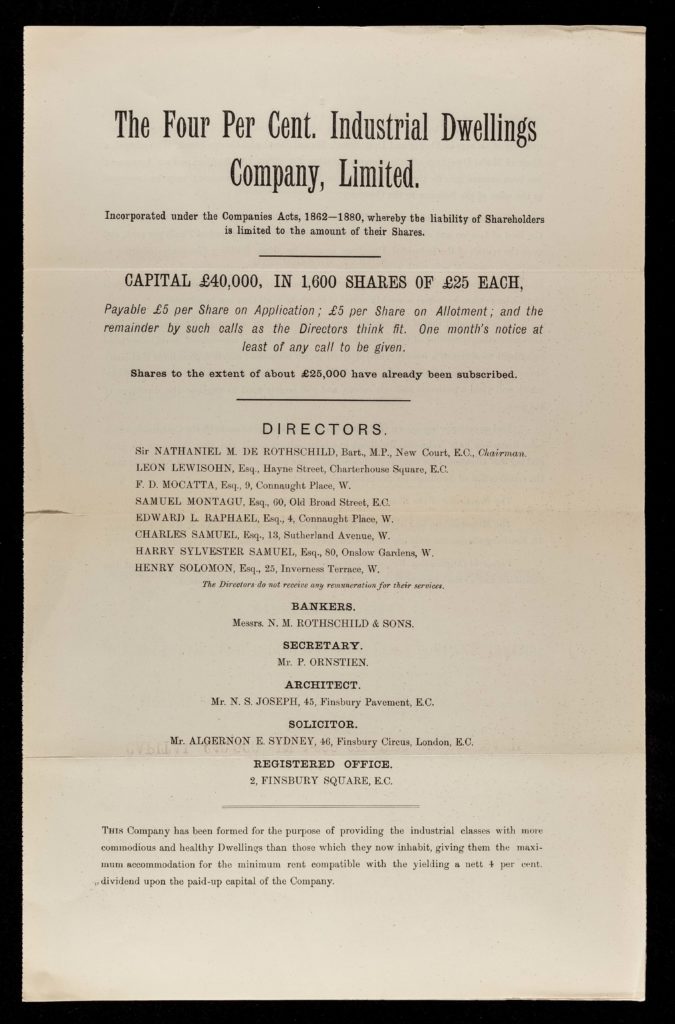The Four Per Cent Industrial Dwellings Company Prospectus

The Four Per Cent Industrial Dwellings Company Prospectus • The Rothschild Archive
The following text comes from thecityoflondon.co.uk’s great history of Jewish London.
Jews are townspeople, not farmers, and rarely lived in the countryside. In whichever towns the settled they clustered together, for self-protection, for reasons of language and culture, and to be within walking-distance of a synagogue. In the late 19th century and first half of the 20th century London’s main Jewish Quarter was in the Whitechapel, Spitalfields, and Mile End Old Town districts, and the parish of St. George-in-the-East. They were areas that had previously been settled by earlier Huguenot and German immigrants. The former people had largely assimilated and moved elsewhere but the less affluent German community remained in Whitechapel and St. George’s until the First World War. Towards the end of the 19th century 90% of the capital’s Jews lived in East London and 40% of the population of the Borough of Stepney were Jewish. The East End took on an exotic character: streets filled with people speaking Yiddish, Lettish (from Latvia) or German; men dressed in black jupizes (long coats) and with side-curls; Germanic names and Hebrew lettering over the shopfronts; kosher butchers; Jewish booksellers; and Jewish music-halls.
The East End area of two square miles was one of the most densely populated in the whole of England. Throughout the second half of the 19th century railway companies ran lines through East London, razing many homes along the way. Residents simply moved a few streets away, creating increased overcrowding as the number of houses decreased and the population grew with new arrivals. There were some streets of fine houses, albeit run-down, as well as mean slums, small, stinking alleyways and narrow courtyards. As with London’s other rookeries, water supply and sanitary conditions were often poor, which only began to improve when a new water authority was created after 1903. Refuse was often left to rot. Conditions inside many homes were bad, with leaking ceilings, damp walls, and foul water closets. In 1884 The Lancet published a report that galvanised the Jewish Board of Guardians into appointing an inspector of housing. Of those properties initially checked 93% were found to not have flushing toilets. Jews, tended to crowd more people into each dwelling, encouraging landlords, often themselves Jews, to charge higher rents than to Gentiles. The latter were then forced out of properties and whole streets became part of the Jewish ghetto. Many Jewish families took in lodgers, perhaps someone newly-arrived. Overcrowded homes were the norm, often with eight or nine people sharing two small rooms, and many doubled-up as workshops. Hence, much of home life was spent outside on the doorstep or in the street.
From the 1870s London’s slums were gradually cleared to make way for social housing. In 1884 the United Synagogue reported on the state of East End housing. This resulted in two private social housing companies. The Four Per Cent Industrial Dwellings Company, providing a four percent return to investors, was founded and chaired by Nathan Rothschild. (It still exists as the Industrial Dwellings Society). Samuel Barnett of the St. Jude’s church at Whitechapel was the primary instigator of the East End Dwellings Company.
Read more about the Prospectus from the Rothschild Archive here.
Discover more Hidden Treasures
Hidden Treasures: Celebrating the documents, photos and artefacts in British archives that tell the story of Jews in Britain